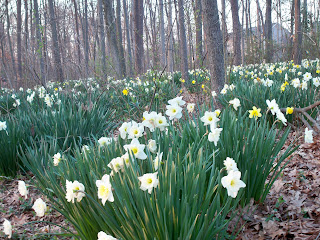My Heart With Pleasure Fills
I’m thinking of that poem, the one we learned in elementary school, the one that seems jaded and obvious — until you stumble upon it in real time.
The other day I rounded the corner of a paved path and there was my own “host of golden daffodils.”
Or not my own, actually. That was the beauty of it. They were for everyone, were wild and free, glorifying not just a single backyard but a widespread and well traveled community woods. Tucked among the oaks and maples and just a few feet away from the skunk cabbage.
I slowed my pace as I strode beside them, wanting to savor their beauty as long as possible. Other amblers did the same that sweet spring morning. There was a hush in the air, a reverence for the blossoms.
I did not wait for “the inward eye, which is the bliss of solitude.” I took no chances. I used a camera. And now, as I look at the photograph, I remember the flowers’ surprising presence in that parceled suburban landscape. The words flow into my mind before I can stop them: “And then my heart with pleasure fills, and dances with the daffodils.”

